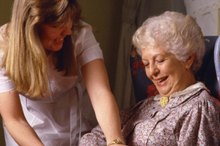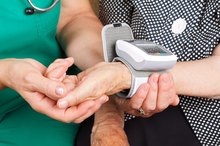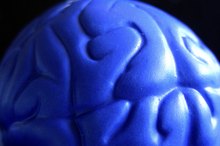A Nursing Diagnosis for Seizures
Seizures are caused by abnormal discharge of neurons that lead to physical and behavioural disturbances. "Pediatric Hospital Medicine: Textbook Of Inpatient Management," by Ronald M. Perkin, James D Swift and Dale A Newton, says that seizures should be considered as symptoms of central or systemic nervous system dysfunction. Nursing diagnoses for seizures may be formulated based on problems with safety, medication therapy and knowledge of the condition. "Risk for trauma" is a nursing diagnosis for seizures.
Types of Seizures
There are different types of seizures. Generalized tonic-clonic seizures involve muscle contraction, foaming at the mouth with rhythmic contraction and relaxation of the muscles or jerking and loss of consciousness. In generalized absence seizures, there is loss of awareness and sudden loss of voluntary use of the muscles. In this type of seizure, a patient may have a vacant stare.
Simple partial seizures cause jerking movements in one particular part of the body while a person is conscious. Complex partial seizures, on the other hand, may begin as simple partial seizures after which loss of consciousness occurs. Status epilepticus is a state in which an individual experiences continuous seizures all at once. It is a medical emergency and could lead to death.
- There are different types of seizures.
- In generalized absence seizures, there is loss of awareness and sudden loss of voluntary use of the muscles.
Assessment
Audit Tools for Nursing Care Plans
Learn More
In order to formulate a nursing diagnosis for patients who suffer from seizures, nurses conduct interviews to find out how much a patient knows about a seizure and its treatment; how often they have seizures and if they know how long they last, as well as the type of seizures they experience. They also may inquire about factors that may precipitate seizures such as odors or fatigue. Nurses also check to see if the patient has barriers to obtaining seizure medications.
Nursing Diagnoses
After gathering as much information as possible, the nurse then analyzes the information for possible problems that a patient with seizures may have or could develop. Some of these problems could be little to no knowledge about seizures, difficulty taking anti-seizure medication and the possibility of injury during a seizure. Based on these problems, a nurse can formulate nursing diagnoses such as "deficient knowledge," "risk for trauma" and "non-compliance: therapy."
Care Plan
Long-Term Effects of Grand Mal Seizures
Learn More
A care plan for a patient who has a seizure disorder focuses on ensuring that the patient and caregivers of the patient are educated about the disease process behind this disorder, its treatment plan, consequences of not sticking to the treatment plan and safety measures necessary to prevent injuries. The care plan contains nursing interventions that address these goals.
Nursing Interventions
"All in One Care Planning Resource," by Pamela L. Swearingen, suggests that nursing interventions for keeping the patient safe include taking seizure precautions such as:
- padding the side rails of the bed with blankets
- keeping the bed in a low position [1](# 'inline-reference::"All in One Care Planning Resource"; Pamela L
Swearingen
RN
et.al. ; 2004'). These intervention may prevent injury if a seizure occurs. During a seizure, the nurse can keep the client safe by placing the patient in a side lying position and loosening all constrictive clothing to promote breathing and prevent low oxygen levels.
- "All in One Care Planning Resource," by Pamela L. Swearingen, suggests that nursing interventions for keeping the patient safe include taking seizure precautions such as: * padding the side rails of the bed with blankets
* keeping the bed in a low position [1](# 'inline-reference::"All in One Care Planning Resource"; Pamela L Swearingen
* RN
* et.al. - ; During a seizure, the nurse can keep the client safe by placing the patient in a side lying position and loosening all constrictive clothing to promote breathing and prevent low oxygen levels.
Related Articles
References
- "All in One Care Planning Resource"; Pamela L. Swearingen, RN, et.al.; 2004
- "Nursing Diagnosis: Application To Clinical Practice" Lynda Juall Carpenito-Moyet; 2007
- Glauser T, Shinnar S, Gloss D, et al. Evidence-Based Guideline: Treatment of Convulsive Status Epilepticus in Children and Adults: Report of the Guideline Committee of the American Epilepsy Society. Epilepsy Curr. 2016;16(1):48-61. doi:10.5698/1535-7597-16.1.48
- Stafstrom CE, Carmant L. Seizures and epilepsy: an overview for neuroscientists. Cold Spring Harb Perspect Med. 2015;5(6):a022426. doi:10.1101/cshperspect.a022426
- Clinical Epilepsy. In: Bromfield EB, Cavazos JE, Sirven JI, editors. An Introduction to Epilepsy. West Hartford, CT: American Epilepsy Society; 2006.
- Epilepsy Foundation. Types of Seizures. 2017.
- Fisher RS, Scharfman HE, deCurtis M. How can we identify ictal and interictal abnormal activity? Adv Exp Med Biol. 2014;813:3-23. doi:10.1007/978-94-017-8914-1_1
- Epilepsy Foundation. Focal Onset Aware Seizures (simple partial seizures). 2017.
- Epilepsy Foundation. Types of Seizures. 2017.
- Manno EM. Status epilepticus: current treatment strategies. Neurohospitalist. 2011;1(1):23-31. doi:10.1177/1941875210383176
Writer Bio
Ngozi Oguejiofo has been writing on a freelance basis since 2009 and most of her writings are focused on health. She is currently a registered nurse. She is interested in teaching, and writes articles focused on student nurses for various online publications.









